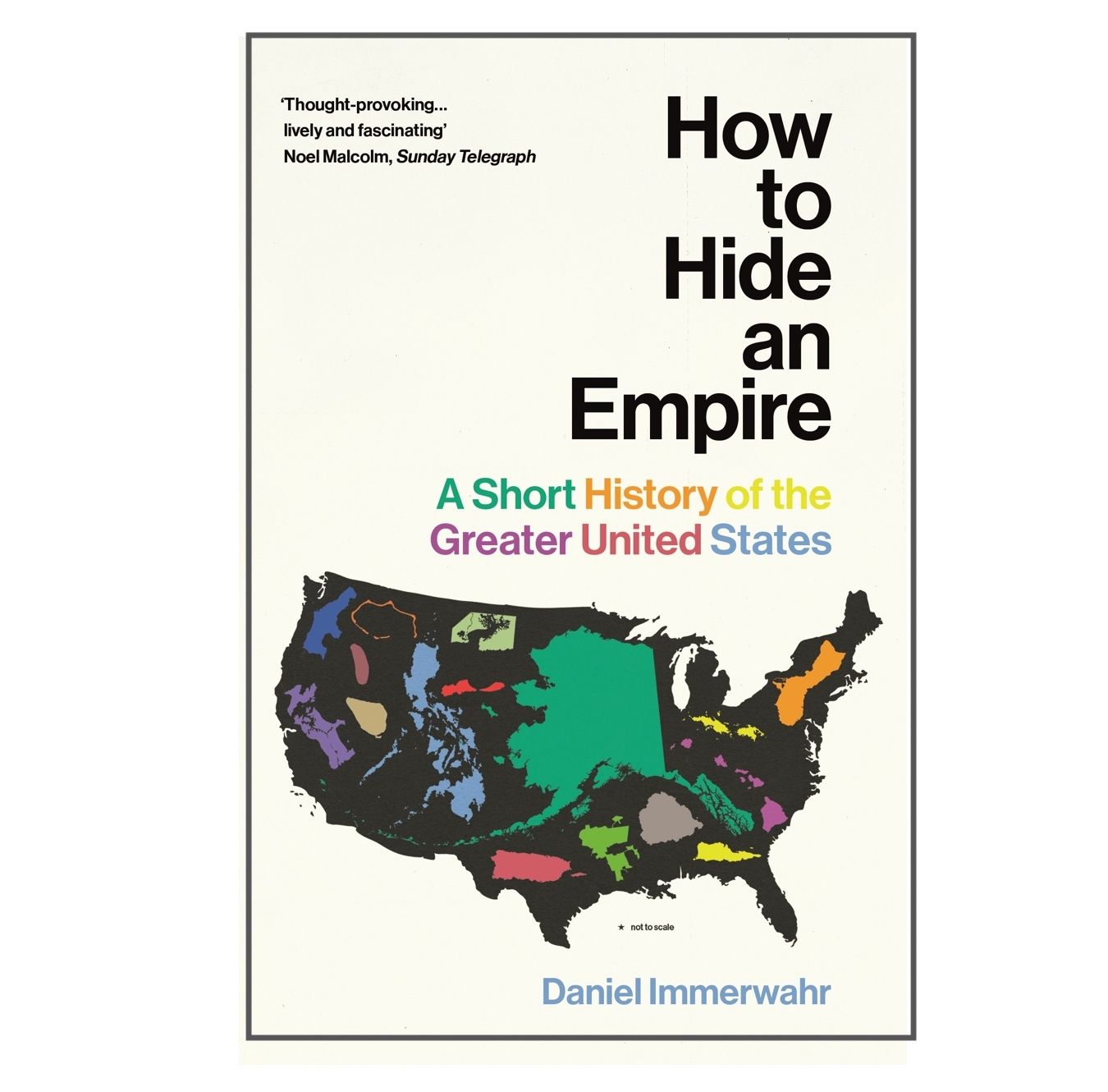
How to Hide an Empire
Peter Sims reviews Daniel Immerwahr's book, 'How to Hide an Empire'. A tour of US imperialism, how it happened, how it shapes our world today, and implications for how we respond to our global predicament (particularly the threat of climate change).

A Short History of the Greater United States
Published by Penguin Books Limited, 2020
This book tells the very important story of the United States of America’s (US’s) imperial past and present. Although it is framed as a reminder to US citizens that they have an empire and an imperial history which are both significant and often overlooked, it is highly relevant to global citizens thinking about geopolitics, ending the use of fossil fuels for energy, and equitable access to minerals in the context of climate change and biodiversity loss.
The book broadly tracks US history from 1775 (a year before the Declaration of Independence from Britain and a decade before it became reality) through to the present day but focusing on the divide between ‘territories’ and ‘states’ and looking at events from perspective of the territories. ‘Territories’ is the word which the US government uses to mean all land that the US claims, but which isn’t a ‘state’ where people living there can elect representatives to Congress and the Senate. The author claims that this perspective is what differentiates his book.
The story starts with the expansion west from the 13 original states to form territories on land which at the time was inhabited by indigenous North Americans. There were attempts by the US government to control the pace at which this happened, but not to address the underlying settler population increase (doubling every 25 years) that motivated it. This expansion brought white settlers and the United States into direct confrontation with Native Americans whose population fell by 90%. A large part of this was due to new diseases (introduced by white settlers and often used as a weapon), the lack of vaccines (which settlers had), and the trauma of dislocation (from war, disruption to food supplies and forced relocation). Amitav Ghosh describes this in The Nutmeg’s Curse as an environmental war and ‘terraforming’ where the landscape on which natives had co-adapted to depend is forcibly changed to European settlers’ vision of what ‘productive’ looks like. Although How to Hide an Empire doesn’t explicitly mention environmental warfare (like deliberately killing buffalo herds on which native tribes depended) it does explore in depth the evidence about deliberate use of European diseases as a weapon.
The book returns to this theme of disease and relocation when it discusses the building of the Panama Canal and the motivation for the development of insecticides to control mosquitoes during World War II (DDT was sprayed from planes to clear islands of life before US military moved into build military bases). Another theme to which the book returns over and over again is that of unequal power relations between different people living within what the USA claims as its territory (or land it had ‘leased’ like Guantanamo Bay). There has been since the beginning a massively racist aspect to this (Hawaii was refused statehood for decades due to its not having a majority white population), as well as broader imperialist and political aspects. The US constitution does not apply in full to everyone born in the US. Not all US citizens get to vote in national / presidential elections to this day. For comparison all citizens of British Overseas Territories are full British Citizens, although they still can’t vote in UK elections unless they have previously lived in the UK itself.
The book then charts the US annexation of one third of Mexico, claiming hundreds of Guano islands and in 1898 its war with Spain in which it gained as territories the Philippines, Gaum in the Pacific and Puerto Rico. The Guano island bonanza in the second half of the 19th century wasn’t unique to the US, but it is particular poignant to reflect on. The short story is that the terraforming of the mainland United States and the settler boom led to rapidly declining soil health which threatened food supplies, and mining fossilised bird shit off remote islands allowed the inevitable need to return to closed loop fertility systems to be put off for another fifty years. Then in the run up to World War I the ‘Habor-Bosch’ process was developed which again put off the inevitable by using energy to convert nitrogen in the air into ammonia suitable for fertiliser and explosives. Although the potassium and phosphorus elements of NPK fertilisers still rely on mineral extraction from ‘territories’ to this day, this technology effectively converts fossil fuels (gas) into nitrogen a key part of soil fertility. This artificial synthesis of what many other countries acquired through colonial control of territory is another reoccurring theme of the book. The Japanese occupation of SE Asia in 1941-2 created such a crisis in the US over rubber supplies that they lowered road speed limits to reduce wear on car tyres and forced chemists from multiple private companies to collaborate to perfect the technology of industrial synthetic rubber production. Within two years the US could turn oil into rubber fast enough to meet all domestic demand as well as all the military demands of the Allies.
Such technology allowed the US to pursue a very different colonial path from that which European countries had followed previously. At the end of WWII, it was ideally placed to annex Japan, large parts of Europe, and re-annex the Philippines but the strategic advantages of doing so were much smaller than they would be been fifty years before. Aviation, wireless communication, development of synthetic substitutes for materials (that previously were only available from far off lands via trade or through colonisation) and most significantly the US’s very significant domestic reserves of coal, oil, metal ores and uranium (not to mention people), all reduced the advantage of controlling large amounts of land territory. Militarily, prior to World War II the US had a small professional army relative to its population but invested heavily in the latest technologies. Although large numbers of troops were mobilise for World War 1, they were demobilised very quickly. This all changed after World War II. The United States did however develop a network of military bases (including Guam, Hawaii, Guantanamo bay) and rapidly expanded its logistical presence in places like Egypt even before formally entering World War II to facilitate the supply of equipment to the Allies. By the end of the war the US had proved that it could airlift large volumes of military equipment to anywhere in the world and built a vast network of airfields, harbours, workshops and bases stretching right around the globe.
This military logistics network still exists today with some adaptions, and runs on oil. It is what allows the US to project military power anywhere on the globe. This is despite a pushback against bases in countries including Japan, Uzbekistan, Kazakhstan Saudi Arabia and the Philippines. The book claims that this reinforces the US policy of favouring small islands, ideally places with little or no population, or a population that has few rights (e.g. Guam). However the US seems to be succeeding more recently in signing agreements for new military access to other countries (i.e. more bases).
Towards the end of the book there is an interesting summary of events round the Middle East in more recent decades and how significant the impact of US overseas bases has been on world events (despite their relatively insignificant size), whether it be the rise of companies like Sony, bands like the Beatles, or the safety and environmental concerns around nuclear accidents (expanded on in more detail by Eric Schlosser), or chemical pollution. US military bases don’t just have military impacts.
From a Green perspective these reflections are important. Although clearly other factors were also significant, it helps explain why the US has so much global power and appears to answer to no one. It helps to explain both how the US ended up with such an unsustainable fossil fuel driven economy and how it forces other countries to follow its approach. How to Hide an Empire doesn’t cover the way in which the US uses the dollar and its power over IMF, World Trade Organisation, World Bank etc to exercise soft power over countries which it does not directly control,neither does it explore the role of NATO or arms exports in US global military power (although this is touched on in the context of US-led global standardisation). Whilst these activities aren’t conventional colonialism, they have been described in our modern world as a form of ‘Neo-colonialism’ which undermines the sovereignty of other countries (particularly democracies). The book does touch upon some example of the US (in particular the CIA) trying to destabilise or undermine foreign governments for its own political aims (e.g. supporting rebels in what is now Panama to declare independence from Columbia so that the US could then do a deal with them to build the Panama canal).
In this way the book is interesting as a study of power and how significant change happens. It is also a very revealing insight (for those of us not so familiar with US culture) into why the US populace thinks in the way it does. Unlike other empires which actively encouraged their citizens to be proud of ‘empire’– a pride that in Europe is now being reconsidered, as empire is mostly in the past and being seen in a new light – the US basically hid and continues to hide its empire from its citizens. And that is not just a recent response to current global sentiments, it has almost always been the case.
There is an argument that the US as a country is a key adversary in the campaign to limit climate change and biodiversity loss. Leaving aside its history, such arguments draw on its lacking an approach to chemical regulation, its very energy intensive way of life, its lack of progress in reducing GHG emissions and much else. However its global power is also massively dependent on fossil fuels, its network for global military bases and its military capability being in turn dependent on them. The US is no longer in the position where it was in 1946 with ample domestic fossil fuel reserves (despite what the ending of this book implies), and uses its military power to maintain access to fossil fuel overseas. I would suggest that the US is as much a fossil fuel state as Russia or Saudi Arabia is, in the sense that phasing out fossil fuels isn’t just a cultural and technological shift. It would entail the US letting go of (or at least letting go of the certainty provided by) the geopolitical power and high grade chemical energy availability that fossils gives them. The imperialism itself would need at least to be challenged and to evolve in nature. If the US is a climate adversary, and the phrase ‘know your enemy’ has any significance, then this book might be a good place to start.

Related book review

Publishers Website




